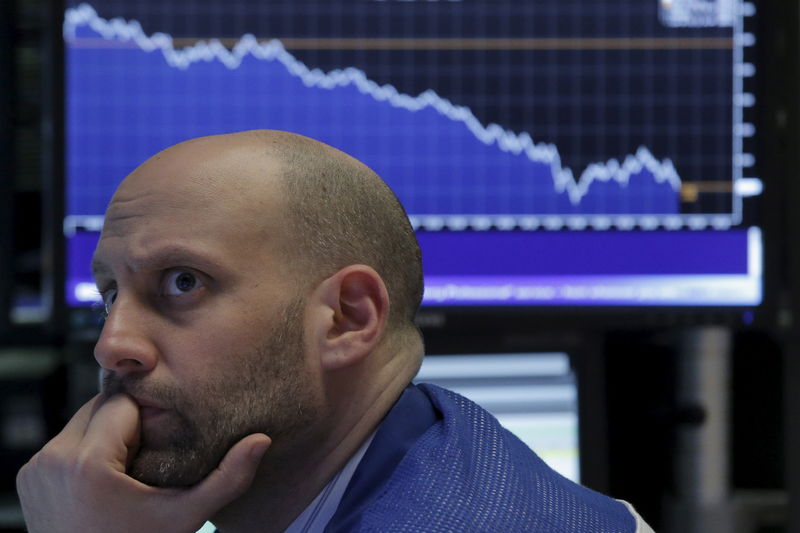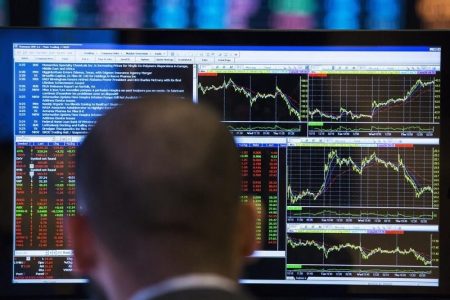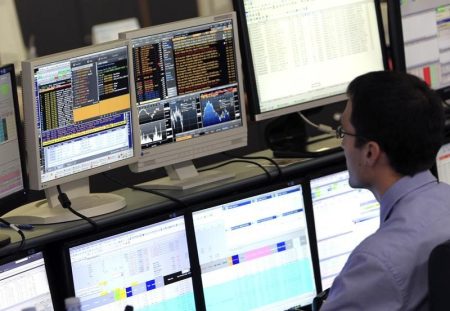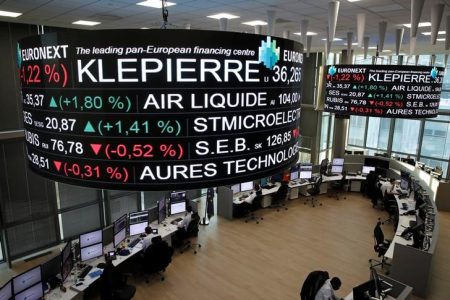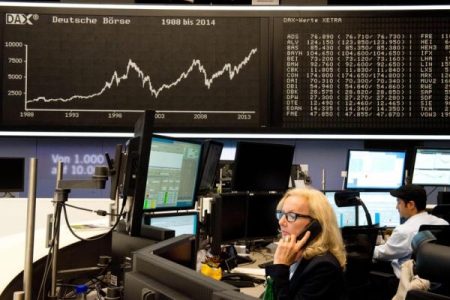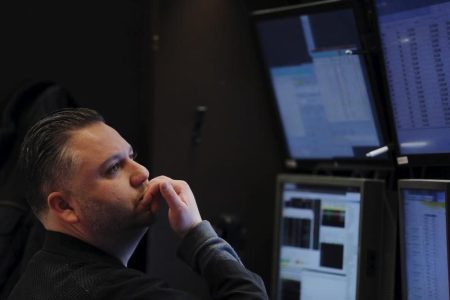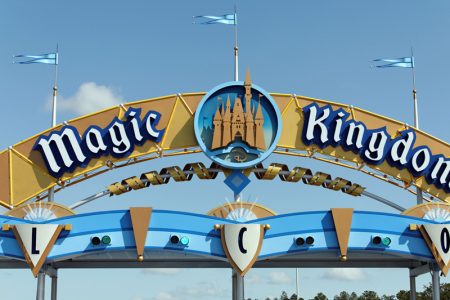© Reuters.
Euronav NV (NYSE:) has reported a record profit for the fourth quarter, with earnings significantly bolstered by the sale of vessels to Frontline (NYSE:). The company’s underlying profit for the quarter was strong at $88 million, supported by a healthy freight market.
Despite these gains, Euronav has opted to withhold Q4 dividend payments until after a mandatory offer period concludes, with a future dividend policy set to be discretionary. The company has also expanded its fleet with the addition of two new very large crude carriers (VLCCs), and has secured new long-term charters, promising a robust outlook.
Key Takeaways
- Euronav’s Q4 profit reached $411 million, with underlying profit at $88 million.
- The company will not issue a Q4 dividend until after the mandatory offer period.
- Euronav added two VLCCs to its fleet, with a total order book of four VLCCs and four Suezmaxes.
- The company’s liquidity has been strengthened to $2.5 billion.
- New long-term charters have been secured with Valero.
- A transaction with CMB.TECH is expected to be ratified, adding to Euronav’s divisions.
- Supply side of the tanker market looks positive with potential for increased scrapping.
- The sale of VLCCs to Frontline will impact cash flow statements in Q4 and Q1.
Company Outlook
- Euronav’s liquidity position is robust at $2.5 billion.
- The company has a remaining capital expenditure of $700 million for its order book.
- Euronav continues to navigate away from the Red Sea due to safety concerns.
Bearish Highlights
- Dividend payments are suspended for Q4 pending the outcome of a mandatory offer.
- The company is facing a tight demand-supply balance in the tanker market.
- Safety concerns are causing Euronav to avoid certain shipping routes.
Bullish Highlights
- Record Q4 profits driven by strategic sales to Frontline.
- Healthy second-hand prices for Suezmaxes and VLCCs.
- Positive outlook on the supply side of the tanker market.
Misses
- Specific details on net proceeds from the Q4 and Q1 vessel sales were not disclosed.
Q&A Highlights
- Operations in Tankers International continue as usual despite the reduced fleet.
- Approval for acquisition at the upcoming SGM requires a simple majority vote.
- Break-even presented for tankers refers to the remaining fleet, with no added costs for avoiding Houthi-threatened areas.
- Bunker strategy will remain market-related without significant hedging.
In summary, Euronav’s strategic moves, including the sale of part of its fleet and the expansion of its fleet with new VLCCs, have positioned the company for a strong financial performance. The company’s decision to suspend dividend payments reflects a cautious approach amid ongoing transactions. As the tanker market shows signs of a positive supply side, Euronav maintains a healthy liquidity position and a clear strategy for navigating market challenges. The upcoming vote on the transaction with CMB.TECH and the consolidation expected in Q1 will be pivotal for Euronav’s future performance.
InvestingPro Insights
Euronav NV’s (EURN) financial performance has been noteworthy, with the company reporting a record profit for the fourth quarter and a robust underlying profit of $88 million. To provide a more in-depth look at Euronav’s financial health and investor benefits, let’s delve into some key metrics and InvestingPro Tips.
InvestingPro Data shows Euronav with a market capitalization of $3.59 billion and a low Price/Earnings (P/E) ratio of 4.14, indicating that the company’s shares may be undervalued relative to its earnings. The adjusted P/E ratio for the last twelve months as of Q4 2023 is slightly higher at 6.08, still suggesting an attractive valuation. Additionally, the company has experienced a significant revenue growth of 91.08% over the last twelve months as of Q4 2023, highlighting its financial momentum.
InvestingPro Tips reveal that Euronav not only pays a significant dividend to shareholders but has also maintained these payments for 9 consecutive years, demonstrating a commitment to returning value to investors. Moreover, the stock generally trades with low price volatility, which may appeal to investors seeking stability. It’s also worth noting that Euronav’s liquid assets exceed short-term obligations, providing the company with financial flexibility.
For investors looking to dive deeper into Euronav’s financials and strategic insights, InvestingPro offers additional tips, including the company’s strong return over the last five years and analysts’ predictions of profitability for the current year. The platform lists a total of 9 InvestingPro Tips for Euronav, which can be accessed through a subscription.
Currently, InvestingPro is running a special New Year sale with discounts of up to 50%. To take advantage of this offer, use coupon code SFY24 for an additional 10% off a 2-year InvestingPro+ subscription, or SFY241 for an additional 10% off a 1-year InvestingPro+ subscription.
In conclusion, Euronav’s strategic sales and fleet expansion, coupled with its impressive financial metrics and shareholder benefits, underscore a company well-positioned for future growth. Investors seeking detailed analysis and more InvestingPro Tips can find them through an InvestingPro subscription, which now comes at a significant discount.
Full transcript – Euronav NV (EURN) Q4 2023:
Operator: Dear all, welcome to the Euronav Q4 Earnings Call. Everyone is muted and the questions can be taken after presentation. I will now give the floor to Alexander.
Alexander Saverys: Thanks very much, Enya. Good afternoon, everyone. And welcome to our Q4 2023 earnings call. My name is Alexander Saverys, I’m the CEO of Euronav; and I’m joined by my brother, Ludovic Saverys, our CFO, and I will immediately hand the word to him.
Ludovic Saverys: Good afternoon, everybody, and thank you for dialing in on our Q4 earnings call. We’ll go through the presentation of the Q4 results, focusing on the financial highlights first and then Alexander will take over on the corporate developments and the tanker markets. And we’re extremely pleased to say that we’ve had our record Q4 in the history of the company. Since 1997, we have been able to deliver a profit for this quarter of $411 million. Obviously, that result has been skewed by capital gains out of the sales of part of the Frontline fleet of $323 million. Nevertheless, the underlying profit of $88 million puts forward a strong Q4 based on the robust freight markets. We’re happy also to include that in Q4 we’ve continued our fleet expansion within Euronav with another two VLCCs, which today still puts us with an order book of four VLCCs on order and four Suezmaxes. The — on the right-hand side of the slide, you can see that the Q4 results were far above our P&L breakeven, but also that the Q1 guidance is going in the right direction. Alexander will continue on that. We fixed for Q1 46% at $50,430 per day for the VLCCs and on the Suezmaxes, we have 54% fixed at $55,000. If you look on the next slide, we are highlighting obviously the key metrics of our company. We still have a leverage on book equity of about 30%. Obviously, with the sale of most of the VLCCs to Frontline, we have strengthened our liquidity dramatically. End of year, we ended the year with $1.243 billion in liquidity. As of today, as most of the vessels of the CO2 Frontline have been delivered, we are close to $2.5 billion in liquidity. The net profits of $411 million, I’ve mentioned, happy also to include that for the full year, we are at the $862 million profit, from which $490 million is coming from the business and $372 million from capital gains. Q4 has also been highlighted by a new chapter for Euronav, which Alexander will continue to explain. We have decided not to do a dividend for Q4 until the mandatory offer is over. Many of the stakeholders within Euronav, investors, analysts and others, have asked us in the last couple of weeks what the dividend policy would be for the company. Previous management and Euronav as a standalone pure-play tanker company has aimed to dividend out 80% of its net profits. Going forward, and if the transaction with CMB.TECH will be consumed next week, the Board of Directors has decided that the dividend policy will be a full discretionary one. I think CMB.TECH shareholder has a track record of rewarding its shareholders, but in terms to give clarity to our investors, the Board of Directors will keep a full discretion on how many dividends will be paid based on the profits. The further growth, we are happy to include in the Q4 two new long-term charters to our first-year client Valero and expand our order book. As of today, within Euronav, we have a remaining CapEx of $700 million throughout the four VLCCs and more than four Suezmaxes. Again, highlighting the fact, which we mentioned in the Capital Markets Day, if the transaction with CMB.TECH would be approved next week, CMB.TECH has an outstanding capital commitment to newbuildings of $2 billion, which would bring the total CapEx commitment of $2.7 billion. One metric we haven’t highlighted and we hope to be able to grow further in the future is the contract backlog on our Marine division. Today stands at a $1.75 billion revenue, and as CMB and Euronav have stated, it is our intention to continue to find attractive opportunities to be able to lock in long-term cash flow. Without further ado, I’ll pass on the word to Alexander on corporate development.
Alexander Saverys: Yeah. Thank you very much, Ludovic. On the corporate development, a lot has already been said over the last couple of weeks. I think if we zoom in on the Frontline transaction, I think, the first thing we can highlight today is that 23 out of the 24 VLCCs have already been delivered to Frontline. You have seen in the Q4 what the result impact is and we’ve also projected the impact of the sale of the 24 vessels or the remaining 24 vessels in Q1. One vessel still needs to be delivered, but we’re expecting that to be within Q1. We also sold the Oceania, our oldest ship in the fleet. This is also being announced today. We’re going to realize a capital gain of close to $35 million, which will be recorded in Q1 2024. Ludovic already said, very important contract done with Valero on a long-term time charter on two new Suezmaxes for delivery in Q2 2026. Then our total order book, part of our optimization strategy, fleet renewal strategy of VLCCs at Beihai shipyard in Qingdao is now four vessels, three of them which will deliver in 2026 and one which will deliver in 2027. So if you look at our total fleet, apart from the two FSOs that we have, we have 17 Vs on the water, plus four newbuildings and 22 Suezmaxes on the water. We have the Bristol delivering very soon, plus another four on order, which are going to come in 2024 and 2026. We go to the next slide. We cannot have this call without mentioning the Red Sea. As you have heard, we were one of the very first companies to avoid the area after the Houthi rebel attacks on merchant shipping. We have not changed our viewpoint so far, so we will continue until further notice to go and choose other routes than through the Red Sea until that situation has become safer for our crew and for our ships. The impact of the diversions can be seen every day in shipping, in general, and I would say, and product tanker shipping in specific, this indeed creating more demand for ships because of the longer ton miles and we’re expecting the situation unfortunately to last at least for the next couple of weeks, hoping for this to be resolved in the following months. We can go to the next slide. Making a little recap what we already did on the Capital Markets Day presentation of what has happened over the past months and what will happen in the next couple of weeks. On the 9th of October we struck an agreement with the Fredriksen Group to get out of the deadlock for Euronav. That deal, that agreement was ratified in November at a special general meeting of shareholders. Just before Christmas we announced the CMB.TECH transaction and next week on Wednesday we will have a special general meeting to vote on that specific transaction. Shortly thereafter we hope to open the mandatory bid for Euronav and we hope to close it by the middle of March. I want to say a few words about the tanker markets as well. As we are in shipping there’s things we know and things we don’t know. If we zoom in on the supply side and the fleet composition, which are things that should be relatively certain, I can only say that the signals are still very positive. If we look at the order book to fleet, even though there has been some recent increase in ordering activity specifically for Suezmaxes and some VLCC, we are still at very low order book to fleet ratios from a historical point of view, and this definitely for the next two years will be very supportive for our industry. Zooming in on the age of the vessels, stating the obvious, with a fleet that is hardly getting scrapped, the age profile of the vessels is increasing, is going up and we are now looking at ages — average ages of the fleet that we haven’t seen for a very, very long time. Again, it should be a very positive signal going forward. We have one more slide, the next slide, that zooms in on the VLCC fleet age profile and order book. Basically you can see there that a big chunk of the vessels is going to reach the age of 20 years in the following years, which means a lot of potential to scrap, which means that utilization definitely has some support, even if demand, and we’ll speak about demand in a second, would stay relatively flat. So only positive things to say about the supply side. Going into the asset prices, the market reacts as it does when the supply-demand balance is tight. We are seeing very, very healthy second-hand prices for both Suezmaxes and VLCCs. If we have to say something negative, I would say that, the VLCC second-hand market has not gone up as the underlying sentiment would have it. It’s been underwhelming a little bit, but we’re expecting this to catch up as the year proceeds, if the fundamentals stay as they are. On the next slide, we have a few graphs on demand. Again, even though demand is growing slowly, it’s the supply-demand balance which is still looking very, very healthy. It’s well publicized that the only new VLCC of the year has already been delivered, so there are no more Vs coming in 2024 and you can see on the slide that the order book for 2025 is indeed very low or non-existent, with a slight growth in demand in oil, this should tighten the balance of supply-demand further. I’m already at my concluding remarks, before we go and take some questions, obviously, for Ludovic and I, this is a Euronav Q4 earnings call, maybe the last one as a pure-play. If the transaction of CMB.TECH on Wednesday is ratified, is agreed by the shareholders, then obviously the next earnings call will zoom in a lot more on all the different divisions that we will have added. But for now, we are open for questions.
Operator: [Operator Instructions] So the first person who can ask a question is Kristof Samoy. You may unmute and ask your question, please.
Kristof Samoy: Hello. Good afternoon, Alexander and Ludovic. I have the few questions, if I may. The upcoming SGM, the approval of the acquisition, is that by a simple majority vote that it needs to be approved or do we need a qualified majority? And then, secondly, best case scenario, when would we see the first consolidation of CMB.TECH if the transaction is approved? And then, secondly, regarding the sale of VLCCs to Frontline, the delivery is spread in fourth quarter and first quarter. Can you give more detail on how this impacts the cash flow statement in the fourth quarter and the first quarter? How many sell off vessels in the fourth quarter in your cash flow statements and how much repayment of borrowings you foresee linked to these sales in first quarter and fourth quarter of last year? And then third question, if I may, on Tankers International. The VLCC vessels which have been sold to Frontline are no longer part of the pool. How do you see this for Tankers International? What’s the impact there? And yeah, how do you see the position of Euronav in Tankers International going forward? Thank you.
Alexander Saverys: Okay. Thank you, Kristof. I’ll take the last question and then I’ll hand over to Ludovic. So, on TI, as we’ve stated before, as far as we’re concerned, it’s business as usual. As you know, we’re a 50-50 shareholder together with INSW. The fleet has obviously reduced, but operations are still going as they were before, and actually, in recent weeks and months, we’ve even added new vessels to the pool from other third-party owners. For the other questions, I’ll hand over to Ludovic.
Ludovic Saverys: Yeah. Great. Kristof, thanks for the questions. On the SGM next week, it’s simple majority, i.e., CMB can vote as well. So, hence, there’s a high likelihood that transaction will go through. On the consolidation of CMB.TECH, we have — the simple answer is that you will see that in the Q1 figures, which obviously will be announced in May. We have put an illustrative balance sheet in the Capital Markets Day where the main point to be pointed out is that we do not take any good will, i.e., the vessels and underwater in CMB.TECH will be passed on at book value in a year and a half. But so, you will see a full consolidation in the Q1 set of results. On the sale of the VLCCs, 11 VLCCs have been sold to Frontline in Q4, with a capital gain of $323 million. 13 VLCCs will be sold to Frontline, i.e., 12 have been sold in Q1 and one is being — will be sold around mid-March with a total capital gain of $372 million for Q1. The total sales amount was $215 million. The exact detail on the net, the full proceeds in Q1, Q4, there, I have to come back to you on that. If you just take an arithmetic average on 11 of 24 vessels, it will be around $1.1 billion in Q4 and then $1.25 in Q1. There was no debt on the ships while being delivered to Frontline. That is because within a year and a half, we have refinanced all the remaining fleets that still remains today in our ownership. We’ve re-leveraged those vessels to 55% of fair market value and we’ve used excess cash out of that to take out the debt on the vessels being sold to Frontline, which means that the $2.35 billion came in as net cash proceeds. Does that answer your question?
Kristof Samoy: Yes. Thank you.
Operator: Okay. Thank you. Then the next person who can ask his question is Thijs Berkelder. You can unmute and ask your question, please.
Thijs Berkelder: Yeah. Thijs Berkelder, ABN-Amro ODDO BHF. Three questions. First, you presented a break-even — P&L break-even for your four-year tankers. Is that a pre-sale of the fleet or post-sale of the fleet, or somewhere in between? Then the second question is, given the situation with the Houthis, et cetera., are you making extra costs for protecting your vessels now, and if so, what amounts should we think of? The third question is on the bunker volumes. What is your bunker strategy going forward?
Ludovic Saverys: Okay. Thijs, thanks. I’ll take the first one and I’ll take the next two ones. The break-even of the tankers as protect — as projected are of the remaining fleet. So, this is going forward, these are the P&L break-evens on both Suezmaxes and VLCCs.
Alexander Saverys: Yeah. And then on the protective measures for the Houthis, we don’t need to take any measures because the best measure is not going there. We are basically sailing around and not crossing the area. In terms of the bunker strategy, Thijs, we are basically keeping a strategy of being full-floating, so market-related. There’s not any significant hedging and we are not doing anything that maybe was done in the past of buying bunkers beforehand and loading it on board of the Oceania, because now the vessel is gone. So we basically go back to the normal strategy of staying on the spot market and not taking any cover. Does that answer your question, Thijs?
Thijs Berkelder: Yes. Thank you.
Alexander Saverys: Thank you. Yeah. Maybe, Enya, before we go back to the question of Kristof, it is what I thought. It’s $1.1 billion in cash came in in Q4 and $1.25 billion in Q1. You can go ahead, Enya.
Operator: [Operator Instructions] Okay. I see no further questions, Alexander and Ludovic.
Alexander Saverys: All right. Great. But we’re always there to answer any questions you might have after this call. Thanks for joining us and see you next week on Wednesday at the General Assembly. Bye-bye.
Ludovic Saverys: Thanks. Bye.
Alexander Saverys: Bye.
This article was generated with the support of AI and reviewed by an editor. For more information see our T&C.
Read the full article here






